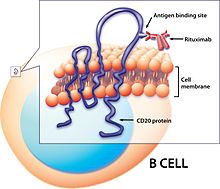Radioligand
[1] Radioligands can be used to analyze/characterize receptors, to perform binding assays, to help in diagnostic imaging, and to provide targeted cancer therapy.Radiation is a novel method of treating cancer and is effective in short distances along with being unique/personalizable and causing minimal harm to normal surrounding cells.[3] John Lawrence, a physicist at The University of California Berkeley, first used nuclear medicine in humans came in 1936 after extensive use of radioactive phosphorus in mouse models.[4] Another pioneer in the field, Sam Seidlin, in partnership with Saul Hertz, treated a case of thyroid cancer with radioactive iodine (I-131) 1946.[6] The use of radioligands and nuclear tagging started to gain popularity in in the early 1960s when Elwood Jensen and Herbert Jacobsen (1962) and later Jack Gorksi, David Toft, G, Shymala, Donald Smith, and Angelo Notides (1968) attempted to identify the estrogen receptor.[9] Gamma rays Positron emission Beta particles A ligand is a molecule utilized for cell-signaling that binds to a target tissue for cellular communication.This structure allows the compound to identify and bind to the target tissue while retaining the ability to be tracked and imaged clinically.The structure of the compound allows clinicians to easily identify the path traveled and the destination via repeated imaging and the signal put out by the radiotracer attached to the ligand.However, the type of radiation used, whether 𝜶, β, or both can have a dramatically different effect on both the target binding site and surrounding tissue.However, due to the shorter path length of these particles, the method of delivery needs to be extremely close to the location of the tumor.[22] Some examples of alpha-emitting radioligands include actinium-225, Ra-223-chloride, and Lead-212.36 β particles emit lower energy as compared to α-emitters, but they have the advantage of having longer path length.However, due to their lower energy, more β particles are required to cause damage to tumor cells as compared to α-emitters.This is the indirect production method and requires elaborate radiochemical separation, purification, and results in large amounts of radioactive waste.Freeze dried kits of Lutathera do show reduced effectiveness in radiation therapy but they maintain radiochemical purity.The patient receives therapy by automated syringe, infusion pump, or gravity using long/short needles, tubing, and sodium chloride solution.General side effects of this radioligand therapy include fatigue, nausea, dry mouth, anemia, decreased appetite, and constipation.[37] For patient eligibility to get Lutathera radioligand therapy the patient must have disease progression despite receiving somatostatin analog therapy (octreotide or lanreotide), have a locally advanced, inoperable, or metastatic well-differentiated disease, and have an Eastern Cooperative Oncology Group (ECOG) performance status of 0 to 2.Furthermore, the radioligand vial is only viable for a limited time and under specific conditions which challenges transport and storage along with feasible application to the patient.Clinical trials of α-emitters are underway due to their higher potency and ability to induce double-strand DNA breaks.







therapeutic radioactive isotopeligandWilhelm RoentgenAntoine Henri BecquerelPierre CurieMarie CurieJohn LawrenceThe University of California BerkeleySaul HertzSociety of Nuclear MedicineJournal of Nuclear MedicineAmerican Board of Nuclear Medicineneuroendocrine tumorsRadioactivity in biologyIodine-125Iodine-123Iodine-131Fluorine-18Iridium-192Xenon-133Yttrium-90Carbon-11Indium-111Strontium-89Lutetium-177Radium-223cell-surface receptorsIon-channel receptorsG-Protein Coupled Receptorsenzyme-linked receptorsPositron Emission TomographySingle Photon Emission Computed Tomographyionizing radiationComputed TomographyMagnetic Resonance ImagingScatchard plotCompetitive bindingalpha-emittersLutatheraZevalinnon-Hodgkin lymphomaradioligand therapyEastern Cooperative Oncology GroupActinium-225Binding potentialDistribution volumePET radiotracerCRC Press